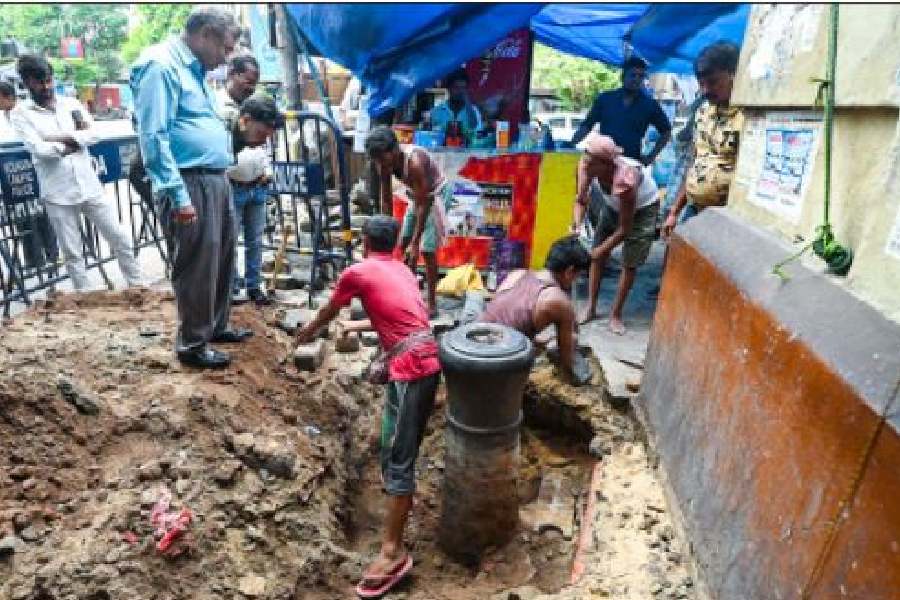An iron object resembling the barrel of a cannon is being excavated at the intersection of Fairlie Place and Strand Road, near the Eastern Railway headquarters in west Kolkata.
The dig started on Wednesday morning and by the evening, around 4ft of the object, with a bore of around 6.45inch, had become visible.
“Going by looks, the object seems to be a British-made cannon. It is possible that the cannon is either an 18 pounder or a 24 pounder and the barrel is 8 to 10 feet long,” said Amitabh Karkun, a war history and firearm enthusiast who is guiding the dig.
The dig is being supervised by Biplab Roy, administrator general and official trustee of Bengal, who has collected more than 40,000 antique objects and other artefacts from across West Bengal, which will be on display at the Judicial Museum and Research Centre that is being set up by Calcutta High Court.
Karkun said the object was buried at least 10 feet below the pavement surface and only a small part was visible.
It had caught Roy’s attention two months back when he was walking to his office at New Secretariat after his car had got stranded in a morning snarl.
He called up Karkun as soon as he spotted the object rising through the pavement. Karkun told him that he had spotted it at least 10 years back and it was likely to be a cannon from the British era.
Roy then decided to retrieve the object and restore it and approached the Kolkata Municipal Corporation and CESC for help in the excavation.
“We have noticed multiple jagged lines around the barrel indicating that some persons had tried to saw it off. But cannons are made in a way that they can seldom be tampered with. The bore, however, seems to have been altered by at least an inch during the attempts to saw it off,” Roy said.
Karkum said the object is made of cast iron and the front resembles British-manufactured cannons that were made in the late-1800s.
The top half of the object seems to be in reasonably good condition. Overall, the metal does not look to have corroded too much despite it being underground for many decades.
“Going by the casting, the cannon seems to have been manufactured in Britain. I can only be sure of the make, model and date of manufacture once the entire object is retrieved and cleaned properly,” Karkun said.
According to him, such cannons have markings on three places, through which one can know the date of manufacture and about the manufacturer.
This is not the first cannon that Roy and his team are trying to retrieve.
Last month, a 10.5ft-long 31-pounder cannon, manufactured in 1796, had been excavated by the team from near Dum Dum Central Jail.
The markings on the object revealed that it is a Blomfield cannon, named after its designer Thomas Blomfield, a Briton who was appointed inspector of artillery and superintendent at the Royal Brass Foundry in Britain.
In the past few years, Roy’s team has restored five cannons, which are now kept in the office of the administrator general and official trustee of Bengal at New Secretariat.
Of the five, one is of Dutch origin. It was found in Chinsurah, Roy said.
Experts said cannons found in Bengal are usually of three categories — pre-Mughal, Mughal and European.
Karkun said the preMughal cannons primarily belonged to the Husain Shahi dynasty, Sher Shah Suri and the Baro Bhuiyans, who used them to fight Mughals in and around Bengal.
Pre-Mughal cannons, he said, have geometric ornamentation on them, while the Mughal ones have floral patterns. British and French cannons are devoid of any such design.
In Kolkata, there are several places that have cannons standing guard like sentinels.
Among them is an 18-mm Krupp gun that was kept at New Market for many years before it was shifted to Town Hall after one of its wheels came off. The gun was used in the Second Boer War (1898-1902).
Tipu Sultan Mosque, at the intersection of Prince Anwar Shah Road and Deshapran Sasmal Road, has 18 cannons that have been retrofitted to serve as lamp posts.
A Chinese cannon is mounted on a dragon right in front of Raj Bhavan.
According to the inscription on it, the cannon was taken from the Chinese in 1842 in commemoration of peace “dictated under the walls of Nankin by the naval and military forces of England and India”.
Fort William, the headquarters of the Eastern Command of the Indian Army, has 73 cannons.
The Rabindra Sarobar compound has at least eight cannons, while the South Gate of the Victoria Memorial has two cannons.
